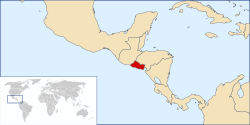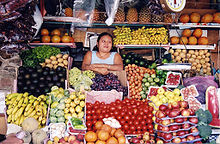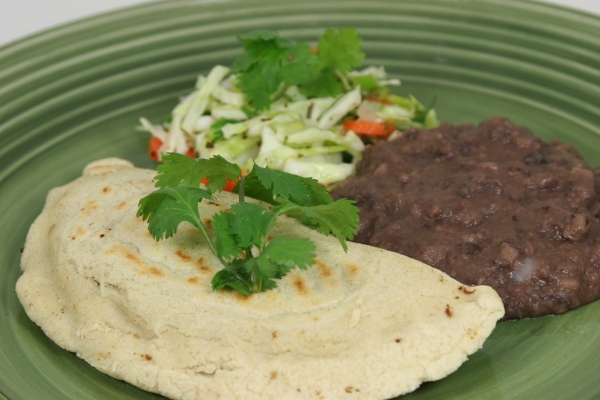 Hello Hungry Travellers! Welcome back and I trust by now that everyone is ready to explore a new destination and discover a new national dish.
Hello Hungry Travellers! Welcome back and I trust by now that everyone is ready to explore a new destination and discover a new national dish.
El Salvador is a small nation on the southern edge of the Central American landmass. It is surrounded by Guatemala to the north and Honduras to the South and East. To travel to it from Egypt, we sail west out of the Mediterranean Sea and west to the Panama Canal. Crossing through the canal we then turn north and sail past Costa Rica and Nicaragua before landing in the department (state) of La Libertad where the coastline is due south from the capital city of San Salvador.
 El Salvador is the smallest nation in Central America, similar in size to Belize. However, unlike Belize, El Salvador is Spanish speaking and is also the most densely populated nation in Central America. Interestingly the official currency of El Salvador is the US dollar, which was adopted in 2001. The previous currency, the Colon, is still legal tender.
El Salvador is the smallest nation in Central America, similar in size to Belize. However, unlike Belize, El Salvador is Spanish speaking and is also the most densely populated nation in Central America. Interestingly the official currency of El Salvador is the US dollar, which was adopted in 2001. The previous currency, the Colon, is still legal tender.
In the 16th century, the Spanish colonized the area calling it Provincia De Nuestro Señor Jesus Cristo, El Salvador Del Mundo, or roughly translated, Province of our Mr. Jesus Christ, the Savior of the world, a lengthy title for a small nation. Eventually it was shortened to El Salvador.
El Salvador was under Spanish rule until the early 1800’s when in 1821 it became a part of the newly independent “First Mexican Empire”. El Salvador resisted the unification of what is now Guatemala, Honduras, El Salvador, Costa Rica, Nicaragua and Chiapas State, Mexico and insisted on independence from Mexico. This was met by suppression for about 2 years until the formation of The Central American Republic, when Chiapas joined Mexico and the remaining 5 territories joined together. In 1839 El Salvador became an independent republic when the C.A.R. dissolved.
 From the mid 19th century onward, the economy of El Salvador relied on Coffee as a single or monoculture agricultural commodity and oligarchies rose up out of the plantation system that was established. This class system would lead to periods of wealth and poverty as world coffee prices rose and fell. Eventually the systemic suppression of the campesinos (field workers) would lead to discontent and cause political unease.
From the mid 19th century onward, the economy of El Salvador relied on Coffee as a single or monoculture agricultural commodity and oligarchies rose up out of the plantation system that was established. This class system would lead to periods of wealth and poverty as world coffee prices rose and fell. Eventually the systemic suppression of the campesinos (field workers) would lead to discontent and cause political unease.
The 20th century in El Salvador was marked by several coups and in the 1980’s and early 1990’s a civil war that was waged between government forces and several guerrilla revolutionary groups of both leftist and communist persuasion. This war has been blamed in large part on the U.S. involvement in creation of a second Junta on the heels of the 1979 coup d’état that overthrew the then sitting government. This second Junta was to be headed by Napoleon Duarte who was recalled from exile in Venezuela. However, the people saw this move as opportunistic which ultimately resulted in its failure and the start of the 1980 Civil War.
El Salvador has begun to see improvement in its standard of living. Economic reforms and the exposure of governmental corruption have balanced some of the inequities in Salvadoran society. However, poverty is still widespread and unemployment is a continuing problem.
 Much of the food of El Salvador is reminiscent of the rest of the region. Spanish influence and regional produce have helped create the Salvadoran cuisine. However, the national dish of El Salvador is believed to predate the arrival of the Spanish. One of my favorite names for a dish is Pupusa. It is a challenge to say this without a smile. Pu-Pu-Sahhhhhhh!
Much of the food of El Salvador is reminiscent of the rest of the region. Spanish influence and regional produce have helped create the Salvadoran cuisine. However, the national dish of El Salvador is believed to predate the arrival of the Spanish. One of my favorite names for a dish is Pupusa. It is a challenge to say this without a smile. Pu-Pu-Sahhhhhhh!
Essentially this dish is made from pan roasting the dough of Maiz Harina, or Corn Flour also called Masa or Maseca that has been stuffed with various items. Unlike tortillas, the dough is thicker and is stuffed before cooking making a derivative of the empanadas that are found throughout Central and South America. Standard toppings include: the also fun to say Chicharone, or fried pig skin, queso blanco or white cheese, and a vinegar based coleslaw called Curtido. Refried beans are a common topping as well and variations on the recipe are limitless.
I have included the recipe for curtido which is a delicious take on a standard American Slaw, minus the mayo or cream dressing. In my case, I chose to leave the ingredients unblanched (as called for in the recipe) and was thrilled with the result. It is the epitome of simple whole and delicious food.
I might also recommend deep frying the pupusas instead of pan baking them. I have eaten them this way before and I think it adds flavor. Of course it adds fat as well so choose wisely!!
CLICK HERE FOR A PRINTER FRIENDLY VERSION
Rating:
Appearance: 3 out of 5
Aroma: 4 out of 5
Flavor: 3 out of 5
Total: 10 out of 15
INGREDIENTS
Masa harina–Powdery corn meal, found at most Mexican groceries. 2 cups
Water – enough to create the correct consistency (See below)
Filling (see variations below) 1 cup
METHOD
Basic Steps: Mix → Knead → Rest → Portion → Roll → Pan-bake.
In a large bowl, mix together the masa harina and water and knead well.
Knead in more water, one tablespoonful at a time, to make a moist, but fairly firm dough. (It shouldn’t crack at the edges when you press down on it.)
Cover and set aside to rest 5-10 minutes.
Roll dough into a cylinder then cut into 8 equal portions. Roll each portion into a ball. You can also use a tortilla press but be sure to not over compress the dough, it should be around ¼ inch thick.
Press a hole in each ball with your thumb. Put about 1 tablespoon of desired filling into each ball and fold the dough over to completely enclose it. Press the ball out with your palms to form a disc. Be sure the filling doesn’t spill out.
Place the dough between plastic wrap and roll it out with a rolling pin.
Heat an ungreased skillet over high heat. Cook each pupusa for about 1-2 minutes on each side till lightly browned and blistered. Remove to a plate and cover till all pupusas are done. Serve with curtido. (See recipe below)
Hint: You can also form the pupusas by using two circles of dough with the filling between and the edges sealed with a fork or by hand. Or, using only one circle, fill ½ of the dough and flip the other side over to form a half moon shape with the filling in between like an omelet, again sealing by fork or by hand.
VARIATIONS
Pupusas can be made plain or filled with any number of ingredients. Cheese, chicharrones (fried pork rinds) or refried beans are the most common fillings. For a cheese filling, use grated farmer’s cheese, mozzarella, queso fresco or Swiss.
If you can’t find chicharrones, grind 1 cup of cooked bacon with a little bit of tomato sauce in a food processor. Cooked potatoes or finely minced, sautéed jalapeño peppers are also tasty fillings. Try a mixture of different fillings.
The above recipe uses masa harina, a special dried cornmeal flour used in making tortillas, tamales, etc. If you are able to get fresh masa, definitely use it instead. The flavor will be much fresher. Just substitute the masa harina and water with fresh masa. One pound will make about 8-10 pupusas.
NOTES
Pupusas are a particularly Salvadoran food. Salvadoran restaurants that serve them are called pupuserías.
Curtido, a type of coleslaw, is typically served with pupusas.
Pupusas are traditionally made by slapping the dough from palm to palm to flatten it out. A Tortilla press might be quicker and easier for beginners. Just line the tortilla press with plastic and press out each ball to about 5-6″ wide and about 1/4″ thick.
CURTIDO
El Salvadoran cabbage salad
Makes about 4-6 servings
INGREDIENTS
Cabbage shredded 1/2 head
Carrot peeled, grated 1 each
Water boiling 4 cups
Scallions minced 3 each
Vinegar, white 1/2 cup
Water 1/2 cup
Oregano, fresh or dried minced or crumbled 2 T or 2 t
Crushed red pepper flakes 1 t
METHOD
Basic Steps: Blanch → Mix → Chill
Place cabbage and carrots in a large bowl. Cover with boiling water and let set for 5 minutes. Drain well.
Mix with the rest of the ingredients and chill.
VARIATIONS
A pinch of sugar and a little oil can be added to the salad if you like.

Thank you to the following site for the excellent recipe and information: http://www.globe-hoppers.com/pupusa-recipe.html
foodista widget

Eric Ackerson is a food writer, blogger and seafood marketing professional. His work takes him to many ports of call around the world. Currently Eric is cooking the national dish of every country on Earth at his blog My Hungry Tum. Eric enjoys travel and says his favorite food cities are Singapore and Vancouver. He lives in Charlotte NC with his wife and two daughters who he says are quickly becoming “foodies” themselves…








